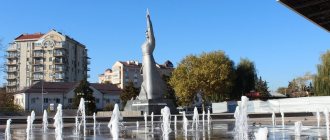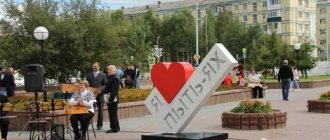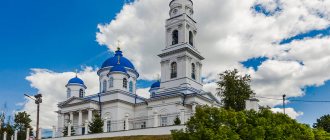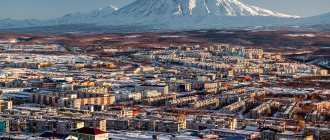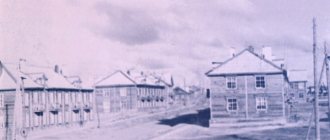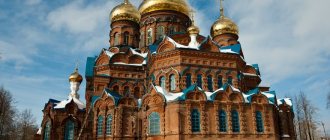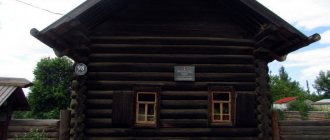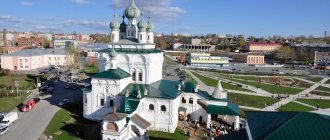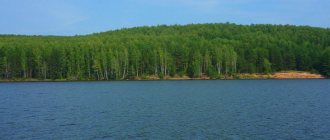Brief information about Kungur
Kungur is located at the confluence of the Iren and Sylva rivers in the Middle Urals, 90 km southeast of Perm. Administratively, the city is part of the Perm Territory and at the same time is the center of the Kungur region.
Kungur is located near the regional center - the city of Perm
The area of the city is about 68 square meters. km. The length from north to south is about 15 km, from west to east - about 8 km. The population is over 66 thousand people.
Economically, Kungur does not have a clearly defined industrial leader. Most of the enterprises are concentrated in the food industry. The tannery and shoe factory, which appeared in the 18th century, is of great importance.
In recent years, city authorities have been paying serious attention to the development of the tourism component in the Kungur economy. This is facilitated by interesting natural places and historical sights of the city.
History of Kungur
The year 1663 is considered to be the founding of Kungur, but in reality a fort with that name arose 15 years earlier than the official date. The first Kungur was located 17 km from the modern city. Now there is a village on this site. The reason for the transfer was the unfavorable defensive position of the fortress. This led to the capture of Kungur by the rebel Bashkir tribes and the death of almost all the defenders of the small fort.
New Kungur was built in a more favorable place, from a military point of view: the steep, high bank of the river served as excellent protection from attack. In 1720, the city became the administrative center of one of the Ural mining districts, and its convenient location eventually turned it into a large merchant center of the Cis-Ural region. Contemporaries recognized Kungur as one of the richest cities in the region. Evidence of this is the monuments of commercial architecture and merchant mansions that formed the attractive appearance of the settlement.
How to get to Kungur
While maintaining its historical role, Kungur remains an important transport hub in the Urals. Two roads pass through the city:
- R-242 is a federal highway connecting Perm and Yekaterinburg;
- R-343 is a road of regional importance between Solikamsk and Kungur.
Parallel to the P-242 highway runs a section of the Trans-Siberian Railway connecting Moscow and the Far East. Travel time by train from Moscow to Kungur will be approximately 24 hours.
The fastest way to get to the city is to use air travel, arriving at Perm International Airport. Regular buses and electric trains run between Perm and Kungur. The travel time will be a little over an hour.
Sights of Kungur
Kungur is a typical merchant city of the Russian hinterland. Its main attractions are pre-revolutionary residential and administrative buildings and Orthodox churches. The saturation of Kungur with ancient objects made it possible to include it in the “Historical Cities of Russia” program in 2010.
Ice cave
The main attraction of Kungur is the Ice Cave. This natural site is known far beyond Russia, so foreign tourists are frequent guests in the city. The Ice Cave is one of the largest in Europe: the length of the underground passages is 5600 m. Of these, 1500 m are accessible to tourists. The discoverers discovered large accumulations of ice in the underground grottoes, so the cave was called “Ice Cave”.
The entrance to the cave is at the foot of the Ice Mountain
The existence of the cave has been known since the time of the first Russian settlers. There were legends that pioneers were hiding in the dungeon back in the time of Ermak. The first detailed description of the cave was compiled in 1703 by the famous Russian cartographer Remezov. During these studies, Orthodox crosses, icons and other attributes of church life were discovered in the grottoes.
Regular excursions were started by a representative of a noble Kungur family, Alexander Khlebnikov. Having visited the USA and seen how a visit to the famous Mammoth Cave was organized there, Khlebnikov decided to apply foreign experience in his homeland. The entrepreneur rented a plot of land near the entrance to the grotto and began leading tours himself.
During Soviet times, the cave turned into a full-fledged tourist complex. Inside there are excursion routes and lighting equipment installed, which made it possible to create amazing light shows in the underground halls.
When visiting the cave, you need to dress warmly - the air temperature in some grottoes is below zero even in summer.
Practical information:
- address: c. Filippovka;
- ticket price: adult - 600 rub. (on weekends - 700 rubles); for children - 400 rub. (on weekends - 500 rubles);
- working hours: from Sunday to Thursday - from 10.00 to 16.00; on other days - from 10.00 to 18.00.
Photo gallery: Ice cave
The first grotto of the cave - Diamond - is decorated with an ice statue of an old man
The abundance of ice in the Polar Grotto gave the cave its name
Illumination completely transforms the Polar Grotto
A bat figurine and red lighting create an ominous atmosphere in Dante's grotto
Traces of the prayer life of Orthodox hermits were once found in the Grotto of the Cross
The underground lakes in the Long Grotto are crystal clear
Illumination creates the illusion of the seabed in the Coral Grotto
Museum of Karst and Speleology
Near the exit from the Ice Cave there is an inconspicuous building of the Museum of Karst and Speleology with an exhibition of Ural natural minerals. The institution was created in 2005 at the Mining Institute of the Ural Branch of the Russian Academy of Sciences. The building also houses the Mining Laboratory, whose workers are engaged in research into the Ice Cave.
The Museum of Karst and Speleology introduces visitors to the natural minerals of the Kungur region
The issue of creating a speleological museum has been repeatedly raised by employees of the Mining Institute and the Ice Cave since 1965. The lack of exhibits and premises, and lack of finance did not allow this idea to be realized. In fact, it turned out that two small halls were enough for the museum, and the lion's share of the exhibits were the personal collections of the laboratory employees themselves and the cave tour bureau. In addition to the exhibition of minerals, the museum also talks about the nature of karst phenomena and the history of the Ice Cave.
Address: s. Filippovka. Ticket price is 50 rubles.
Kungur Historical, Architectural and Art Museum-Reserve
In 2006, the three main museums of Kungur became part of a single museum-reserve. The number of the fund has reached 116 thousand items. The collection was based on exhibits from the Museum of Local Lore, the oldest in the Urals.
Museum of Local Lore
You should start your acquaintance with Kungur with a visit to the Museum of Local Lore, which is housed in one of the oldest stone buildings in the city. It was built between 1758 and 1762 and originally served as the seat of the city administration. In the chronicles of Kungur, the building is better known as the House of the Voivode, or the City Magistrate. The ground floor housed drinking establishments, and the second floor housed the city authorities, who controlled the income from the sale of strong drinks.
The facade of the Kungur Museum of Local Lore above the second floor windows is decorated with an original beetle ornament, preserved from the 18th century
The local history museum was located in the magistrate's building in 1955, although it opened in Kungur back in 1909. The halls display exhibits ranging from the early archaeological cultures of the Urals to modern times. Of particular interest are the 122-mm howitzer from the Civil War and the standard of the Catherine Regiment of 1774 on display in the museum.
Information about the museum:
- address: st. Gogol, 36;
- work schedule: daily - from 10.00 to 17.00, except Monday and Tuesday;
- ticket price: adult - 80 rubles; for children - 40 rubles; for students and pensioners - 50 rubles.
Kungur Art Museum
The art museum is housed in a mansion built at the end of the 19th century. The owner of the house, Grigory Ivanovich Yukhnev, belonged to an old merchant family of Kungur. After the unexpected death of the entrepreneur, the mansion went to his wife, and then became the property of the city mayor, who married her. In 1915, the house was leased to a printing house and post office. After the revolution, the building housed various government agencies. This continued until 2004, when a museum settled here.
The first and second floors of the Kungur Art Museum were built 50 years apart, which explains the difference in their appearance
The museum exhibits paintings by famous local artists Zhuravlev and Melentyev. Some of the works were transferred to Kungur from the Perm Museum of Art. In addition to paintings, the halls display stone-cutting products, ceramics and sculpture. Of particular interest are the plaster figurines skillfully made by workers of the Kungur artel of disabled people.
Address: st. Oktyabrskaya, 21. Opening hours and ticket prices for museums are the same.
Museum of Merchant History
The Museum of the History of Merchants opened in 2007 and is located on the premises of the Maly Gostiny Dvor. The building was built in 1874 at the expense of the Kungur merchant of the first guild, Gribushin. For this reason, for quite a long time the Gostiny Dvor was called the “Gribushinsky building”. Upon completion of construction, Gribushin donated it to the city. This event took place on the eve of the holiday dedicated to the centennial anniversary of the siege of Kungur by Pugachev’s troops. The only requirement put forward by Gribushin to the city authorities is that half of the income from renting out the Gostiny Dvor should go to scholarships for poor students.
Oriental and Old Russian motifs were used in the design of the building of the Museum of the History of Merchants
The museum exposition tells about various aspects of the merchant life of Kungur:
- leather and footwear industry;
- pottery;
- tea and bread trade.
Much attention is paid to recreating merchant life, interiors and costumes.
Museum address: st. Gogol, 38. Opening hours and ticket prices for museums are the same.
Bolshoi Gostiny Dvor
Along with the Small Gostiny Dvor, which now houses the Museum of the History of Merchants, there is also a Large Gostiny Dvor in Kungur. This is the only commercial building of this type that has survived in the Urals. The building, built in 1865 according to the design of the architect Karvovsky, became the hallmark of merchant Kungur. Gostiny Dvor in plan is a closed polygon, along the perimeter of which there are shopping arcades and warehouses.
Together with the Tikhvin Bell Tower, the Big Gostiny Dvor forms a memorable image of Kungur
Until recently, Gostiny Dvor had traditional commercial significance: the building housed offices and shops. The tenants did not take proper care of the safety of the premises, and over time the building acquired a rather unsightly appearance. The issue of restoration of this object is currently being decided. Address: Cathedral Square, 1.
Religious sites
There are many preserved temples in Kungur that will interest connoisseurs of church architecture.
Temple of the Tikhvin Icon of the Mother of God
The Temple of the Tikhvin Icon of the Mother of God - the main one in Kungur - has existed since approximately the middle of the 18th century. In the 80s of the 19th century, the church underwent reconstruction. In particular, a new 70-meter bell tower was erected. Immediately after construction, the tower tilted 3.5 degrees, ending up on the world list of “leaning” towers. During the Soviet years, the church building housed a children's cinema, which at one time was considered the best in the Perm region. In 2002, the temple returned to the fold of the church, and restoration work began. Address: st. Sitnikova, 52.
The bell tower of the Church of the Tikhvin Icon of the Mother of God has a slight slope
Transfiguration Church
The Transfiguration Church is one of the few surviving examples of the “Ural Baroque”, built in 1781. Its peculiarity is two floors. On the first is the Church of the Kazan Icon of the Mother of God, on the second is the Church of the Transfiguration of the Lord. The building was returned to believers in 1994, and the restoration of the original appearance of the church continued for about 10 years. Address: st. Uralskaya, 6.
Snow-white walls and a green roof make the Transfiguration Church stand out from the general background of the city.
Cathedral Mosque
The Kungur Mosque is a monument to human perseverance. The temple was built in 2007 with donations from the Muslim community. For almost 8 years the building remained at the foundation level. Lack of funds did not allow construction to continue, but thanks to the help of a number of organizations and the city public, the mosque was completed. Address: st. Sitnikova, 7.
The construction of the Cathedral Mosque was helped by the famous public figure of Kungur Amir Makhmudov
Kungur exotica
There are two unusual monuments in Kungur that will definitely decorate a traveler’s photo album:
- The center of the world. This unusual composition appeared in the city in 2007 thanks to the efforts of local public figure Amir Makhmudov. The monument does not claim to assign Kungur the status of any geographical center. The idea was to give originality to the city's appearance as part of the program "Kungur - the cultural center of the Perm region." The idea of the monument was awarded several awards as the best modern tourist attraction. Address: intersection of st. Uralskaya and Gogol.
Any tourist can be proud of a photograph against the backdrop of the Navel of the Earth - Nikita Letun. There is a legend that during the time of Ivan the Terrible, in the Aleksandrovskaya Sloboda near Moscow, one young man built artificial wings and, jumping from the bell tower, made the first flight in Rus'. Kungur aviation enthusiasts decided to honor the memory of the Russian Icarus and erected a monument to Nikitka in the historical center of the city. The monument was built in 2009. Address: square at the intersection of Gogol and Oktyabrskaya streets.
Nikitka Letun became the second exotic attraction of Kungur
Monuments of Kungur - TOP-7 things to see
In any city or town, monuments are an integral part of its history. They are usually dedicated to some historical figure or events that once took place here.
Memorial sign to the pioneers of the Kungur region
- Address: Gogol street.
According to the existing legend, Ermak Timofeevich and his squad spent the winter in these places in 1580 during a campaign in Siberia. The monument is made in the form of a Cossack plow. A guiding star placed on a sail leads pioneers to new lands and opens up new horizons.
The shuttle is installed on a high stele. The sculptural composition is located on the embankment near the Sylva River. The monument was erected in 1990. It harmonizes well with the surrounding landscape.
Sylvensky Bridge
- Coordinates on the map: 57.432585, 56.942023.
This building can be considered a monument only conditionally. The bridge is a vivid reminder of the confusion and indifference to one's work during the formative years of Soviet power. Tradition says that the bridge, built in 1932, was supposed to be used as a railway crossing in Kurgan. But, due to someone's oversight, he was sent to Kungur.
They say that this is the only bridge in the Urals that has a similar design. And, although the legend is not confirmed by any documents, it is part of the history of the city. The bridge still serves the townspeople today to cross the Sylva.
Obelisk to the defenders of Kungur from Pugachev’s troops
- Address: Karl Marx street.
In 1774, Pugachev’s troops tried to take Kungur by storm. But that did not happen. The defenders of the city, led by Second Major A. Papov, repelled 4 assaults by the rebels.
In honor of this victory, a memorial obelisk was opened in Kungur in 1893. The author of the work was the architect N. Voskresensky. The material of the monument is gray marble. Slabs decorated with monograms of royal persons were installed on it. On one of the slabs there was an inscription of gratitude.
During Soviet rule, the monument was renamed and the double-headed eagle was replaced with a star. The original appearance of the memorial stele was returned in 2000.
The center of the world
- Address: Gogol street.
This unique monument appeared in Kungur in 2007. Many consider it the most visited place in the city. The navel of the Earth is a granite hemisphere with a wind rose around it. The inscriptions at the monument indicate the distance from Kungur to other cities and some capitals.
According to the authors, the composition recalls the past heyday of the city, that the former merchant city has now become a tourist center, has economic and cultural ties with many cities and countries. Tourists immediately came up with a new belief. The navel of the Earth is capable of fulfilling your wishes, you just have to touch it.
Monument to merchant Gubkin
- Address: square near the Museum of Local Lore.
Alexey Semenovich Gubkin is a merchant and philanthropist who founded a dynasty of tea traders. He began his activity back in 1840. Gubkin became the main popularizer of the aromatic drink. With his help, tea turned from a little-known drink into one of the most popular in Russia.
They planned to erect a monument to the honorary citizen of Kungur back in 1915. They were able to bring the idea to life only after almost 100 years (this was done in 2007). A bronze life-size figure of a merchant is located in the park near the Museum of Local Lore.
Monument to the samovar
- Address: Sovetskaya st., 22.
It would be strange in a city considered the tea capital of Russia not to have a monument dedicated to one of the most Russian symbols of tea drinking. The monument to the samovar appeared in Kungur in 2009. The author of the composition was the sculptor G. Merkuryev.
His creation stands on a medium-height pedestal. The samovar, gleaming with its copper sides, is ready to prepare an aromatic drink. Above it is a ceramic teapot, and below, on a saucer, there is a large cup waiting for guests.
Monument to Nikita the Flyer
- Address: Aeronautics Square.
Dreams and aspirations of people that are not realized often become legends and are passed on from generation to generation. The legend about Nikita the Flyer is one of these legends.
The boy, having built wings, jumped from the height of the church bell tower and flew. He did this repeatedly, moving from one hill to another. Nikita became the first conqueror of the sky. His happiness did not last long. The Russian Icarus was executed by order of Ivan the Terrible - ordinary people should not strive to conquer the heavens.
In Kungur, in the Aeronautics Square, they erected a monument to the people's dream, embodying it in the image of Nikita the Flyer. This sculptural composition was created by sculptor Alexey Zalazaev in 2009.
Don't miss: Sights of the Perm region
Winter and summer in Kungur
City authorities are actively working to make Kungur attractive for visiting at any time of the year. Natural and climatic conditions made it possible to create a ski infrastructure in the city for winter recreation, and to hold a grand Aeronautics Festival in the summer.
Skiing
There are two ski resorts in Kungur, which are located on the slopes of Ice Mountain:
- "Stalagmite". This ski resort is part of the hotel complex of the same name and is located in the suburb of Kungur, the village of Filippovka. There are 4 trails at the base with a maximum height difference of 60 m and a length of 200 m. The complex is equipped with a rope tow. Practical information:
- cost of daily ski rental - from 400 to 900 rubles;
- the cost of the lift is 60 rubles. in one lift.
The slopes of the Stalagmite base attract mainly experienced skiers - "Firefly". This complex operates on the basis of a children's and youth sports school and is located at st. Uralskaya, 95. The base offers hotel services, meals, and equipment rental. Unlike the Stalagmite base, the Firefly complex is more aimed at children. The trails here are not difficult and are quite suitable for initial training. Practical information:
- cost of daily ski rental - from 300 to 800 rubles;
- the cost of the lift is 40 rubles. in one lift.
The gentle slopes of the Svetlyachok base are ideal for initial ski training
Aeronautics Festival "Sky Fair"
The aeronautics festival “Sky Fair” became a tradition for Kungur in 2002. The initiator of the event was retired military pilot Andrei Vertiprahov. In collaboration with Kungur public figure Amir Makhmudov, also a big aviation enthusiast, this event was turned into an important event not only for Kungur and the Perm region, but also for Russia. Aeronauts from abroad began to actively participate in the festival. The event is held annually at the end of June and ends with the celebration of the city's day.
The rise of hot air balloons in the night sky is an incredibly beautiful spectacle during the Sky Fair ballooning festival.
Holidays with children in Kungur
Parents can easily find traditional fun for children in the city park of culture and recreation. It is located within the boundaries of Oktyabrskaya, Gogol, Lenin, Sovetskaya streets. If children want something unusual, then welcome to the village of Ermak or the fairy-tale world of the Ice Cave.
Ermaka village
The ethnographic complex “Ermak’s Village” is a fenced area with wooden huts in the Old Russian style and many sculptures depicting the plots of Russian fairy tales:
- "Turnip";
- "By magic";
- "Dragon".
The ethnographic complex is part of the Ice Cave Museum-Reserve and is located in close proximity to the entrance. Open seven days a week. Ticket prices are 25–35 rubles.
Photo gallery: sculptures in “Ermak’s Village”
The sculpture “Turnip” plays on the main plot of the fairy tale, contained in the phrase “They pull and pull, but they can’t pull it out.”
The sculpture “At the Command of the Pike” depicts the fairy-tale hero Emelya sitting on a Russian stove
The Serpent Gorynych occupies a worthy place among fairy-tale heroes and sculptures in the village of Ermaka
Video: Ermaka village
The fairy-tale world of the Ice Cave
In addition to regular educational excursions, the Ice Cave offers special programs for children. One of the popular excursions is the project “Tales of Bazhov”. During the program, the guide acts as a narrator, commenting on animated scenes - a meeting with Danila the Master and the Mistress of the Mountain. The length of the excursion space is 1500 m, duration is 1.5 hours.
Animated stories from the fairy-tale world of the Ice Cave will be interesting for children
Ethnopark "Ermaka Village"
The village of Ermaka is an open-air museum that introduces visitors to peasant life. It was located near the Ice Cave. Visitors while waiting to go to the cave pass the time with interest.
This park is the venue for:
- holidays in the style of Russian traditions;
- excursion “The Mystery of Ermak”, dedicated to folk life and work, culture, customs of the Russian people;
- excursions in the form of the fairy tale “Visiting the Ataman,” intended for small children.
The park is surrounded by a wooden fence with a beautiful gate. On the territory there are wooden sculptures based on Russian fairy tales: favorite characters, heroes, animal figures. You are allowed to climb on them, which children really like. Swings for children and slides have been installed. Photo areas are equipped.
A monument to Khlebnikov, the chief keeper of the cave and the first tour guide, was erected. He led people through a cave without a main entrance. To get into it, you had to wind your way for several hours.
All exhibits are made of wood
Interesting wooden buildings: houses, a mill, a chapel, huts. “At Timofeich's” visitors will be fed a delicious lunch. It is prepared using old Russian recipes. In “Ermak’s Izba,” presenters dressed in Russian national costumes will introduce you to the traditions of hospitality. Mead, brews, sbiten are dishes offered to guests for tasting.
Holiday options in Kungur
Depending on the time available to the tourist, the program of stay in Kungur can be divided into several options:
- One-day. In this case, you should definitely visit the Ice Cave and take a walk through the historical center of the city.
- Three days. This option will allow you to add visits to major museums and historical sights to your vacation program.
- Weekly. With such a reserve of time, the traveler will also be able to visit natural sites, taking advantage of numerous excursions of the Stalagmite tourist complex.
In my opinion, the best vacation option would be a 2-3-day stay in the city. During this time, if you have previously worked out the route, you can have time to see all the sights and take a walk in nature.
City `s history
Kungur was founded in the middle of the 17th century and got its name from the Kungurka River .
Thanks to its advantageous position on trade routes, the city developed rapidly in the 18th and 19th centuries. The former wealth of the city is clearly evidenced by the numerous luxurious merchant houses that have survived to this day. Thanks to this, Kungur can be called a real open-air museum, where you can walk for a long time. It is also important that everything related to tourism is well organized in Kungur: there is a map of attractions.
You will find a map next to the “Navel of the Earth” and then building your route in the city is as easy as shelling pears, there are many good hotels, local souvenirs and local food. And in Kungur, the clergy are very friendly: in the local churches it is not at all necessary for women to wear scarves and skirts, which, frankly, really amazed me!
Photo by: Vladimir Kotikovsky
In the 19th century, many Kungur merchants were widely known the Urals A.S. Gubkin , M.I. Gribushin , A.G. Kuznetsov . They were successfully engaged in the tea trade. In the 19th century, Kungur was even called the tea capital of Russia ! Representatives of the tourism industry are talking a lot about this now. Kungur was included in the Great Tea Route tourist route .
Adviсe
Tourists should be aware of some of the dangers of the urban environment of Kungur:
- Every year at the end of April - beginning of May the city is at risk of flooding. As a rule, rising water levels in local rivers do not lead to catastrophic consequences, but they seriously complicate movement around the city.
Water levels in local rivers may reach dangerous levels and flood some roads - The Kungur region, as an integral part of the Perm region, is located in a zone of high tick activity. The incidence of encephalitis has increased in recent years, therefore, when going into nature in the vicinity of Kungur, it is necessary to wear closed clothing, use repellents and carefully examine the body after a forest walk.
- A large number of mosquitoes in the Urals and Siberia is a well-known fact. Residents of the Kama region treat this disaster with humor and even organized a humorous annual event, the Russian Mosquito Festival. But visitors to Kungur may have a hard time, so it’s worth taking care to use mosquito repellents.
- The traditional trouble for Russia did not spare Kungur either. The condition of the roads is such that a few years ago the public even came out for a rally. Since then, there has been some improvement in road repairs, but travelers arriving in Kungur by car should still beware of potholes and pay close attention to the road surface.
Kungur Ice Cave
Most travelers to Kungur are attracted by the most beautiful and striking cave in the Urals and Siberia - the city's most famous landmark. People who have visited it talk about the magical atmosphere inside the grottoes.
Scientific research has revealed that the age of the cave is about 12 thousand years. There are 48 grottoes inside. Each of them has its own name and history.
Those that are open to visitors are equipped with paths, lighting, and a ventilation system. Their vaults are strengthened. The cave does not contain allergens or toxic substances. The air has a high level of purity. In most of the grottoes the temperature is close to 0°C. In the Vyshka grotto, even in summer it is -17°C, and in the Brilliant grotto - -2°C.
The length of the explored grottoes is 5.6 km, and the path intended for tourists to visit is 1.5 km. In terms of its length, it ranks 7th in the world. Kungur Cave is a unique natural structure made of stone and ice. The first map is known to exist, indicating the existence of a mysterious pyramid, which has not yet been discovered. There is an opinion that mysterious phenomena occurring in abandoned grottoes (luminous balls, fiery flashes, figures of mysterious creatures) come from this pyramid. Sometimes people who find themselves in the labyrinths of a cave lose their sense of reality. They start to wander.
Famous personalities visited the cave:
- Princess Victoria of Battenberg and her daughter Louise. The steep stone steps were later called “ladies' tears” because the future Swedish queen injured her knee on them.
- Marshal Zhukov also remembered these steps. He kept the lump as a souvenir.
- The actress who played in the TV series “Simply Maria” is Victoria Ruffo.
- Actors Abdulov and Nikulin.
- Poet Yevtushenko.
- Pilots Chkalov and Gromov.
And how many legends exist about the cave? One of them tells about a beautiful and prosperous city that existed in this place, which an evil sorcerer turned into stone. There are also such legends:
- They say that Ermak's gold is hidden in it.
- Strange inhabitants wander through the labyrinths of stone - the tear-stained bride of the cave spirit is lost, having exchanged her beauty for his mythical wealth.
- An interesting legend is about the Long-legged White speleologist, who fell into one of the wells of the cave and broke his leg. The friend who was next to him abandoned him. Since then he has been kidnapping traitors and traitors.
Over the millennia of its existence, the cave has become overgrown not only with legends, but also with stalactites - icicles hanging from the ceiling, and stalagmites - icicles growing from the floor
This is a very beautiful sight. In low caves they connect with each other. The shape of these icicles is the most unpredictable. There are various bizarre figures. At the entrance to the diamond grotto, they formed a frozen waterfall; in other places you can see animal figures.
There are over 60 lakes in the cave. The largest is the Big Lake. Its depth reaches 5 meters, and its area is 1460 m2. The temperature of the water in the lakes is influenced by the atmospheric conditions in the grotto. For example, in Bolshoye Lake it was recorded near +5°C. The lakes in the Giant Grotto are covered with ice in winter, and in the Vyshka Grotto in some years the lakes froze to the bottom.
The cave is open to visitors every day from 9 a.m. to 4 p.m. You can get on the sightseeing tour at 10, 12, 14, 16 o'clock, and with the laser show - at 11, 13, 15 o'clock. Groups over 11 people require advance registration. The location of the cave is the village of Filippovka near Kungur.

